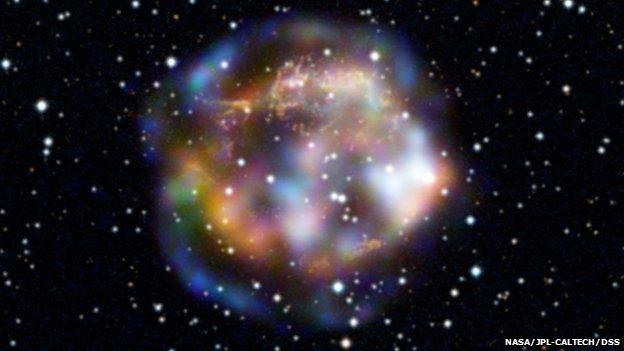Black holes seen by new X-ray eye
- Published

Spiral galaxy IC 342: Nustar sees the high-energy X-rays from two blazing black holes (magenta). Nustar's data has been superimposed on a visible-light view of the galaxy
The highest-energy orbiting X-ray observatory ever devised has begun to share its unique view on the cosmos.
The Nuclear Spectroscopic Telescope Array, or Nustar, was launched in June 2012, but is already bearing fruit.
Researchers reporting at the 221st American Astronomical Society meeting, external released two striking Nustar images.
One details the leftovers of the supernova of Cassiopeia A, and another shows a new view of two feeding black holes in the spiral galaxy IC 342.
The Nustar mission, external aims to cover a higher-energy regime than the existing US space telescope Chandra and the European XMM-Newton, both launched in 1999.
The Nustar team, led by Fiona Harrison of the California Institute of Technology, released the pictures as an early taste of Nustar's capabilities.
"These images have a combination of crispness and sensitivity that is orders of magnitude better than ever made before in this region of the electromagnetic spectrum," Dr Harrison told the meeting.

Scientists are having to learn how to deal with the effects imposed on them by the extendable mast
She said that the team was still getting to grips with the telescope's unique architecture, which holds its X-ray optics on a flexible boom some 10m from the detector as the craft orbits the Earth every 90 minutes.
"We're learning how to point it and we're dealing with the fact that as we go around the Earth, we go in and out of shadow.
"[The boom] moves and we have a complicated metrology system that puts all the images back together to make the crisp pictures."
The team's picture of Cassiopeia A, 11,000 light-years distant, shows a ring of high-energy X-rays surrounding existing data in wavelengths we can see, and lower-energy X-rays from Chandra.
Meanwhile, two black holes first spotted by Chandra are extraordinarily bright in the high-energy X-rays that Nustar can see.
They appear much brighter than similarly sized black holes - providing the first of many mysteries that the Nustar team hopes to uncover, and then to solve.

The exploded star remnant Cassiopeia A: Blue indicates the highest energy X-ray light. Nustar is the first to see this source. Red and green trace lower energy X-rays
- Published13 June 2012